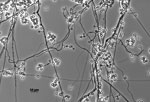Volume 23, Number 2—February 2017
Etymologia
Etymologia: Emmonsia
Emmonsia (Figure) is a genus of soil fungus that can cause adiaspiromycosis, a pulmonary disease common in wild animals, but rare in humans, as well as disseminated disease. When aerosolized spores are inhaled, they enlarge dramatically, from 2–4 μm to 40–500 μm in diameter. Because these swollen cells do not replicate, Emmons and Jellison termed them “adiaspores” (from the Greek a [“not”] + dia [“by”] + spora [“sowing”]). Emmonsia was first described by Chester W. Emmons, senior mycologist with the US Public Health Service, as Haplosporangium parvum in 1942. In 1958, it was reclassified into a separate genus and named in honor of Emmons. Recent phylogenetic analyses have concluded that fungi in this genus are polyphyletic, and proposed taxonomic changes may render the genus name obsolete.
References
- Ciferri R, Montemartini A. Taxonomy of Haplosporangium parvum. Mycopathol Mycol Appl. 1959;10:303–16. DOIPubMedGoogle Scholar
- Emmons CW, Ashburn LL. The isolation of Haplosporangium parvum n. sp. and Coccidioides immitis from wild rodents: their relationship to coccidioidomycosis. Public Health Rep. 1942;57:1715–27. DOIPubMedGoogle Scholar
- Emmons CW, Jellison WL. Emmonsia crescens sp. n. and adiaspiromycosis (haplomycosis) in mammals. Ann N Y Acad Sci. 1960;89:91–101. DOIPubMedGoogle Scholar
- Schwartz IS, Kenyon C, Feng P, Govender NP, Dukik K, Sigler L, et al. 50 years of Emmonsia disease in humans: the dramatic emergence of a cluster of novel fungal pathogens. PLoS Pathog. 2015;11:e1005198. DOIPubMedGoogle Scholar
- Sigler L. Adiaspiromycosis and other infections caused by Emmonsia species. In: Hay RJ, Merz, editors. Topley and Wilson’s microbiology and microbial infections. 10th ed. London: Arnold Hodder; 2005. p. 809–24.
Figure
Cite This ArticleRelated Links
Table of Contents – Volume 23, Number 2—February 2017
| EID Search Options |
|---|
|
|
|
|
|
|

Please use the form below to submit correspondence to the authors or contact them at the following address:
Ronnie Henry, Centers for Disease Control and Prevention, 1600 Clifton Rd NE, Mailstop E03, Atlanta, GA 30329-4027, USA
Top